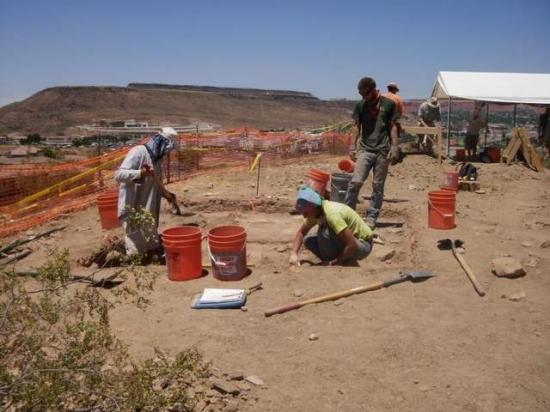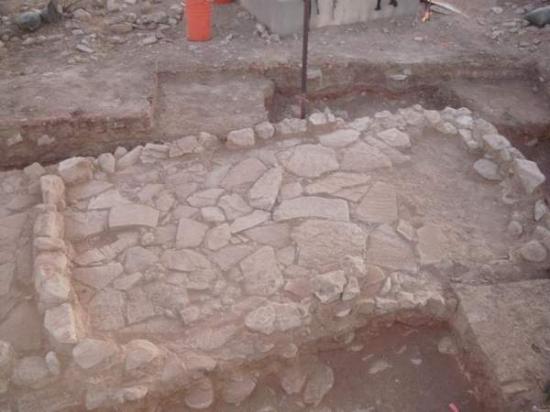Eric Hansen / UDOT
Source - http://www.thespectrum.com/article/20140222/NEWS/302220012/UDOT-makes-archaelogical-discoveries-Tonaquint?&nclick_check=1

Workers carefully unearth archaeological finds in the Tonaquint area of St. George. / UDOT
In 1849, a group of 20 Church of Jesus Christ of Latter-day Saints pioneers from Parley P. Pratt’s legendary exploration of Southern Utah ventured south from Cedar City into the St. George Basin. They followed the meandering course of the Virgin River and … “Continuing cautiously, they come to the confluence of the Virgin and the Santa Clara Creek at a place the Indians called Tonaquint” (from “A History of WashingtonCounty: From Isolation to Destination, by Douglas Alter and Karl F. Brooks,” 2007).
The hill above the confluence — currently called Sand Point — was the original Tonaquint. The name was bestowed by local indigenous inhabitants, the Tonaquints, culturally affiliated with the modern Shivwits, who farmed the fertile banks of the Santa Clara River.

Though some artifacts have been destroyed over the years, others have managed to remain intact. / UDOT

Recent archaeological investigations at the Tonaquint site, resulting from construction of the new Dixie Drive Interchange, reveal that the place had been occupied sporadically and sometimes intensively over the past 2,000 years. Upon initial inspection of the area, it was assumed that the site’s information potential was extremely limited. Most of the site had been removed during the construction of I-15 in the late 1960s. Large portions of what remained had been graded and leveled with heavy machinery. A borrow pit, two freeway billboard signs and a maintenance road left large footprints of subsurface disturbance; and the few remaining locations considered worth testing had been vandalized and were pocked with pot holes and looters pits. Further exacerbating the archaeological context, the place had been used periodically during historic and modern times as a dump. While most of the trash had been removed, leftover debris remained dispersed over much of the site area.
But 150 years of historic and modern disturbances had not entirely removed the site’s hidden wealth of information. Under the direction of UDOT’s region archaeologist, investigation of the Tonaquint site ensued from March through October of 2010. Volunteers from the Arizona Strip Site Stewards and the St. George community assisted contract archaeologists by providing both labor and knowledge. The effort resulted in uncovering buried remnants of numerous prehistoric houses, storage and utility structures, fire pits and prehistoric trash features, and an assemblage of more than 30,000 ceramic and stone artifacts. Analysis of the artifact assemblage was only recently completed.
The newly documented finds correspond to several different episodes of Native American use ranging from the Archaic Period (before 400 B.C.) through the Historic Period (1849-1964). By far, the most well-represented episodes are associated with Virgin Anasazi (Ancestral Puebloan) Basketmaker and Pueblo period occupations. Specifically, this includes the period of time between AD 650 and AD 850 (Basketmaker III and Pueblo I) and between AD 1000 and 1175 (Pueblo II).
The Basketmaker and Pueblo occupants apparently cultivated maize, beans and squash along the adjacent fertile floodplains of the confluence, an ideal setting for a farming community. The confluence of the Virgin and Santa Clara rivers also would have provided abundant wetland resources (fish, birds, cattail and sedges) that supplemented cultivated resources. Grinding slabs and bedrock mortars provide evidence of how some of these resources were processed. Both cultures built semi-permanent living and storage structures, although Pueblo groups are thought to have been more sedentary and reliant on farming than their Basketmaker predecessors. A gradual transition in architecture from semi-subterranean pithouse dwellings to above-ground pueblo structures occurs between the two periods, possibly reflecting the increased sedentism.
Analysis of the ceramic assemblage, consisting mostly of small pot sherds — intact vessels were not found — indicated that a variety of ceramic vessels and utility wares were used for storing, processing, serving and cooking. Painted designs identified on some sherds aided analysts in establishing a chronology of the different occupational episodes. The presence of trade wares (non-local ceramics) indicated trade relationships and potential cultural ties with indigenous groups from areas around Mount Trumbull, Moapa, and the Uinkaret and Kanab Plateaus. Hunting was a common activity as indicated by the presence of numerous arrow heads and an assemblage of animal bones that included deer, rabbit, bird, canine and rodent.
Tonaquint was occupied at the time of first contact by early LDS explorers. Tonaquints farmers exploited the same resource-rich environment as previous occupants of the site had done over the course of at least 2,000 years. The location may have figured prominently in regional prehistory as it provided an abundance of natural resources and semi-exclusive views of potential travel corridors leading from the Virgin River Gorge and the Santa Clara River. Though the site had been severely impacted by over a century of ground-disturbing activities and vandalism, sufficient buried cultural deposits remained intact to allow for careful and methodical scientific investigation. As a result of the Dixie Drive archaeological investigations, important parts of the site’s story have been revealed as well as a wealth of archaeological information about the prehistory of the St. George Basin and the region as a whole.
Materials collected from the site will be curated at the Museum of Natural History in Salt Lake City and will be available for future scientific research.